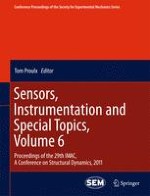2011 | OriginalPaper | Chapter
Acoustic Fluid-Structure Interaction of Cars and Ships (Tutorial)
Author : Lothar Gaul
Published in: Sensors, Instrumentation and Special Topics, Volume 6
Publisher: Springer New York
Activate our intelligent search to find suitable subject content or patents.
Select sections of text to find matching patents with Artificial Intelligence. powered by
Select sections of text to find additional relevant content using AI-assisted search. powered by
Acoustic fluid-structure interaction is a common issue in automotive applications. An example is the pressure-induced structure-borne sound of piping and exhaust systems. Efficient model order reduction and substructuring techniques accelerate the finite element analysis and enable the vibro-acoustic optimization of such complex systems with acoustic fluid-structure interaction. This tutorial reviews the application of the Craig-Bampton and Rubin method to fluid-structure coupled systems and presents two automotive applications. First, a fluid-filled brakepipe system is assembled by substructures according to the Craig-Bampton method. Fluid and structural partitions are fully coupled in order to capture the interaction between the pipe shell and the heavy fluid inside the pipe. Second, a rear muffler with an air-borne excitation is analyzed. Here, the Rubin and the Craig-Bampton method are used to separately compute the uncoupled component modes of both the acoustic and structural domain. These modes are then used to compute a reduced model which incorporates full acoustic-structure coupling. For both applications, transfer functions are computed and compared to the results of dynamic measurements. The vibro-acoustic behavior of ship-like structures is noticeably influenced by the surrounding water and thus represents a multi-field problem. In this tutorial, fast boundary element methods are applied for the semi-infinite fluid domain. As an advantage, the Sommerfeld radiation condition is satisfied in an exact way and only the boundary, i.e. the ship hull, has to be discretized. To overcome the draw-back of fully populated matrices, fast boundary element methods are applied. The focus is on the comparison of the multipole method with hierarchical matrices, which are set up by adaptive cross approximation. In both cases, a half-space fundamental solution is used to incorporate the water surface, which is treated as pressure-free. The structural domain is discretized with the finite element method. A binary interface to the commercial finite element package ANSYS is used to import the mass and stiffness matrices. The coupled problems are formulated as Schur complements, which are solved by a combination of iterative and direct solvers. Depending on the applied fast boundary element method, different strategies arise for the preconditioning and the overall solution. The applicability of these approaches is demonstrated using a realistic model problem.
